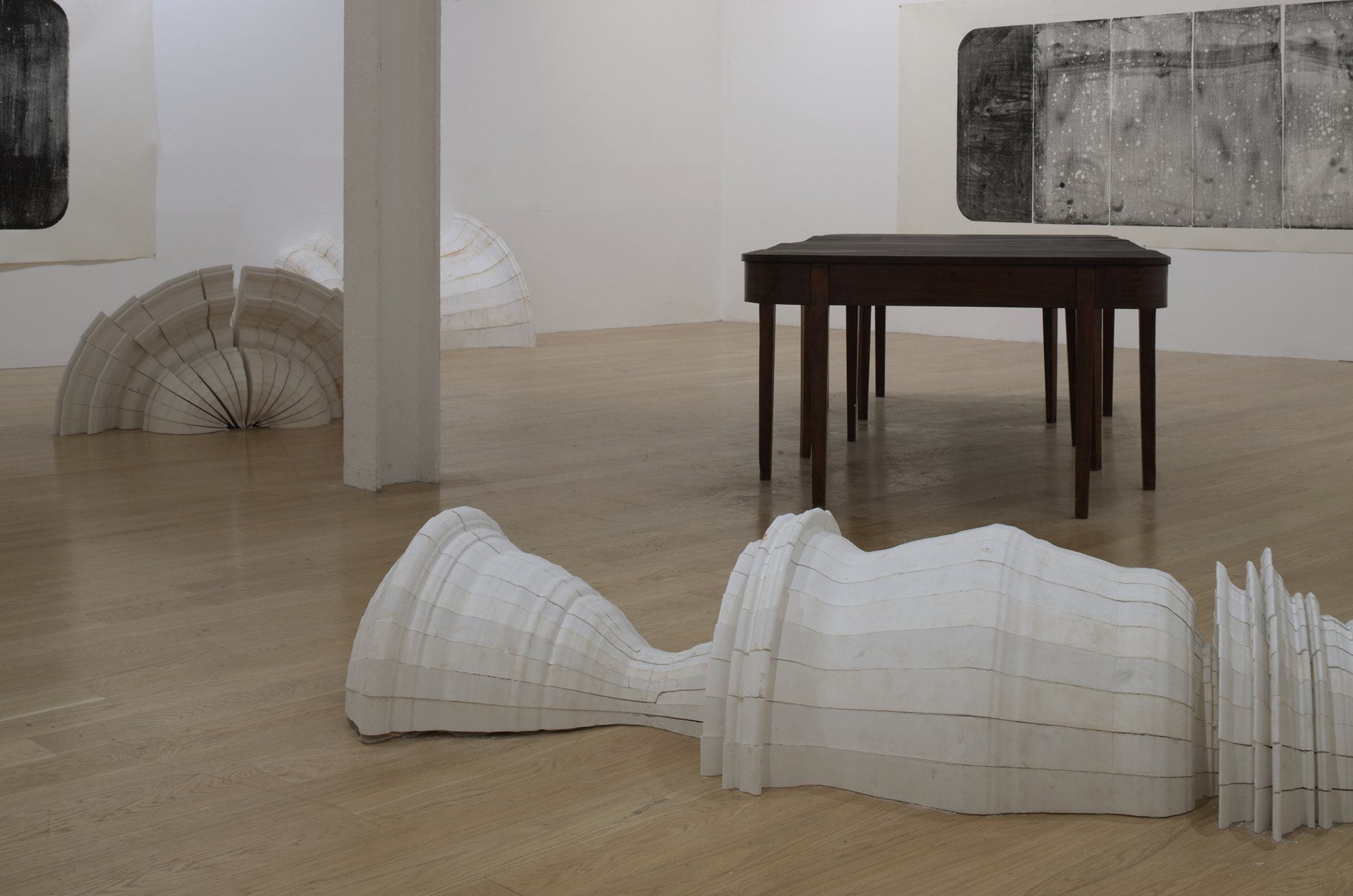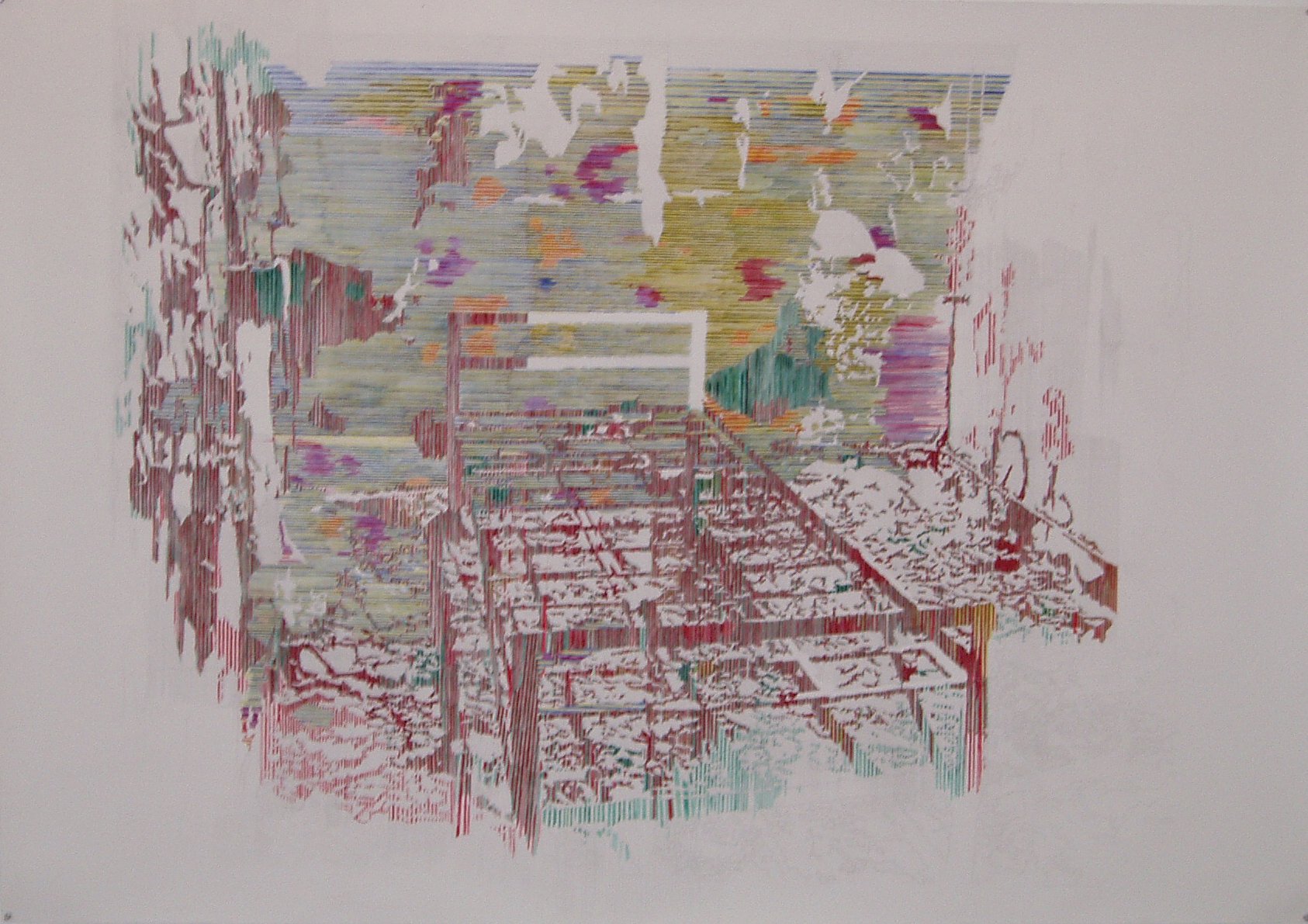Lucy Skaer
Reviewed by Nikos Mantzios
⁰¹ Lucy Skaer, Room of Lines, 2008. Courtesy The Fruitmarket Gallery and the artist. Photo: Ruth Clark.
⁰² Lucy Skaer, _Solid Ground - Tibia_, 2006, pencil and watercolour on paper, 140 × 200 cm
‘Beyond a certain point there is no return. This point has to be reached.’
— Franz Kafka, Reflections on Sin, Suffering, Hope, and the True Way
The works of Glasgow-based artist Lucy Skaer deal with a notion of ‘hidden Death’ behind the domain of public images, where Death stands as a signifier of ocular flatness and repetition. Her studio practice approach suggests a radical questioning and rethinking of the very idea of visual perception and investigates ritualistic potentials as a cure against our empty participation in a world of visual saturation. Skaer’s work combines a variety of media: drawings, sculptures, films and installations, where the three dimensional works often originate in themes from the drawings (her most typical medium) relocating historical appropriations and uses of a wide variety of found images into sculptural patterns. The works project a silent resistance; they are the results of an elaborate, time consuming and methodological deconstruction of the image, which often follows an intention to eliminate the visual authority and transform it into a three-dimensional object. It would be difficult to compare Skaer’s ‘ritualisms’ to another craftsmanship or practice. In her works she intends to picture the time spent for making them, like someone who attempts an embroidery of no obvious purpose or a letter in the size of a book, a path — or labyrinth — where you know beforehand you are going to get lost on the way.
This text is based on Skaer’s summer solo exhibition at the Fruitmarket Gallery in Edinburgh, featuring works since 2001 as well as specific, commissioned installations which utilise subjects like the medieval Dance Macabre and a portrayal of surrealist artist Leonora Carrington. In certain drawings, such as the monumental The Great Wave (Expanded), 2007, based on Hokusai’s iconic theme, Skaer employs a drawing technique of repetitive doodles, applied with graphite on long stretches of paper usually prepared with a grid, which result in what appears as well-wrought feats of self-disciplinary gestures. The doodles in a sense function as a means of re-coding the visual presence of the source image into a scriptural repetitive practice. At the same time the technique evokes a formalistic escape against the immediacy of the photographic image. In this laborious process of repetitive marks in works like The Great Wave the composition follows a certain discontinuous approach giving the impression that the extent of the forms’ lay out is determined at an uncertain moment when things can neither go forth nor back. It feels as if the work stops when ‘a point of no return’ has been reached.
Skaer transfigures found visual material from the internet, newspapers, books and iconic works of art, taking on the role of the artist who, on the one hand invests a sceptical quality towards our perception of mass produced, media imagery and on the other investigates a field where the juxtaposition of gesture against representation is dealt with as an aesthetic phenomenon. The historic discourse relating to undermining the representational criteria in the meaning of a painting or drawing inevitably expands to a polemic against the traditional socioeconomic manipulations behind the power of (popular) images, and this can be seen undoubtedly as a recurring issue in visual arts. If, for example, Magritte’s work poses a doubt in regard to the universal domain of visual perception, it aims at the same time at a provocation of the bourgeois perception in understanding a representational work. In this discourse Skaer opposes ‘ambiguity’ to representation and she often imposes visual handicaps which resist an immediate recognition of the work’s subject.
Solid Ground-Tibia, 2006, based on an image of a cell from a Philadelphia prison, is a colour drawing where the technique literally conceals what is meant to be depicted. This work, like the drawing Depth/River, 2005, creates an unwelcoming, dazzling effect, through the use of contrasting stripes of red and green. In the same vein, in Flash in the Metropolitan, 2006, a collaborative video with, also Glasgow-based artist, Rosalind Nashashibi, ancient statues and artefacts inside the Metropolitan Museum of Art in New York have been filmed during the night while the Museum was closed to the public. The ancient figures appear momentarily and repetitively through the darkness by a strobe light while the camera moves randomly along the museum chambers. This evocation of disorientation by obliterating the museum’s visual authority, the base upon which the institutional status of museums is founded, points at sociological argumentations located in ‘dialectics of resistance’ against urban planning, which favoured an expansion of museums in late 19th and early 20th century; an argumentation also formulated in texts of surrealist thinkers such as Georges Bataille.
Although most of the biggest European museums were established during the 18th century, it was in the 19th and 20th centuries when museums’ popularity reached its peak. In that context, Emile Zola criticised the expansion of squares and museums calling them ‘frames of nature’ and a bourgeois idea [i], while Bataille took this argumentation further when, places like the La Villette slaughterhouse, deemed too ‘dirty’ for the public eye, were removed from central Paris to be replaced by ‘cleaner’ sites. Bataille ascribed a religious dimension to this and projected slaughterhouse as a Labyrinth: a ritualistic structure, superseded by a visual one, the museum. In the context of Skaer’s dealing with images one can argue that the preoccupation with a ‘visual resistance’, manifests a reflection of the ‘visual violence’ lying on photographic images; as Ronald Barthes suggests, not because the subjects are violent but because ‘on each occasion (the photograph) fills the sight by force, and in it nothing can be refused or transformed’. [ii] In that sense works like the drawing Wood and Trees, 2005, can be seen as explorations of the ‘transformability’ of the photograph, in this example by creating a composition where two different photographs are intermingled, one of trees and one of wooden detritus, from which certain elements become repetitive (such as the trees) while anything not made of wood is blotted out. The drawings tend to form random but self-contained jigsaws, presenting a kind of ‘inverse narrative’ against the photo-originated subjects. If the photograph imposes ‘an asymbolic Death, outside of religion, outside of ritual, an abrupt dive into literal Death’ [iii] than Skaer’s technique reintroduces the ‘lost ritual’ behind the image, at the cost of increasing the distance between the meaning of the photograph and the meaning of the work. It can be argued that in every representation these two meanings, the subject and its resemblance, are always oppositional; in Skaer’s work though transformation becomes more prominent than representation. The works remain open to alternative interpretations while projecting a delicate and affectionate materiality. They tend to be presented as not images at all, introducing time to the emptiness of an image.
I find that the most intriguing and intense moments in the show were the works that formed a build-up of pictorial ambiguity. Paradoxically for the same reason there are moments, such as the Room of Lines, an installation commissioned for this exhibition, when the work appears to narrow down its directness by being elusive, moments when ambiguity turns entirely obscure for the viewer. The Room of Lines forms a separate installation with an eloquent intention of playing along the cross-line of two-dimensional forms transgressed into three dimensions and vice versa. A Georgian table is placed in the middle of the room, surrounded by four woodcut prints on the walls, which have been printed against the surface of the table. In a reverse method, dancing cadaver silhouettes taken from medieval illustrations of the Dance of Death are used for creating a series of identical wedges, fitted together in order to form 180-degree and 90-degree symmetrical plaster shapes. The historical presence of death here together with an outmoded object sets up a scene where, as Benjamin puts it, ‘objects can be suddenly transformed into revolutionary nihilism’. [iv] Still, there is a non-clearly stated fetishism in the installation towards the objects’ history while, to a certain extent, the meaning in the dialogue between the objects relies largely on the captions.
Skaer invested much preparation for the show in another work specifically made for the exhibition, the Three Possible Edges, a monumental drawing piece displayed on the inner side of a triangular structure, intervening in the gallery space. The work blends images from a battleship, police horses and a whale skeleton enlarged back to life-size with the characteristic painstaking procedure of her drawings. On the other hand, the installation Leonora follows a narrative structure which combines drawings and objects with a film documenting the surrealist artist Leonora Carrington, whom Skaer met in Mexico, and a table inlaid with mother-of-pearl (in the shape of Leonora’s hands). Conversely to the minimised presence of human figures in the works the figure of an aged Carrington appears among them as a ghost or a shadow.
Compared to previous exhibitions of Skaer I’ve seen, the Fruitmarket show presents a less formalistic and more pluralistic overall impression. The persistent presence of the past on the other hand reflects a general interest among the Scottish grassroots’ art scene in reviving outmoded subjects and palimpsests relating to architecture, literary fictions, memente-mori and Gaelic traditions. In Vitamin D [v], Martin Herbert refers to the story of Skaer’s work as the story of the eye; perhaps implying a connection between the Bataillian Story of the Eye and the image of the corpse (a frequent subject for Skaer), as an image which is ‘the next closest resemblance to a human (besides the — living — human itself)’. [vi] For Bataille on the other hand, who envisaged the human being as a complex of ‘little Deaths’, disorientations and discontinuities, putrefaction is classified as a taboo that reveals a highly disturbing moment of our discontinuous nature. Skaer’s discontinuity ‘leads us to Death, and through Death to continuity’. [vii]
Nikos Mantzios is an artist who lives and works in Edinburgh.
[i] Dennis Hollier, Against Architecture: The Writings of Georges Bataille, The MIT Press, London, 1989.
[ii] Roland Barthes, Camera Lucida: Reflections on Photography, Vintage, 1993, p. 91.
[iii] Ibid., p. 92.
[iv] Walter Benjamin, Surrealism, 1929.
[v] Emma Dexter (ed.), Vitamin D: New Perspectives in Drawing, Phaidon Press, 2005.
[vi] Lucy Skaer, channel4.com, artists’ profiles.
[vii] Georges Bataille, Eroticism, Marion Boyars, 2006, p. 25.

